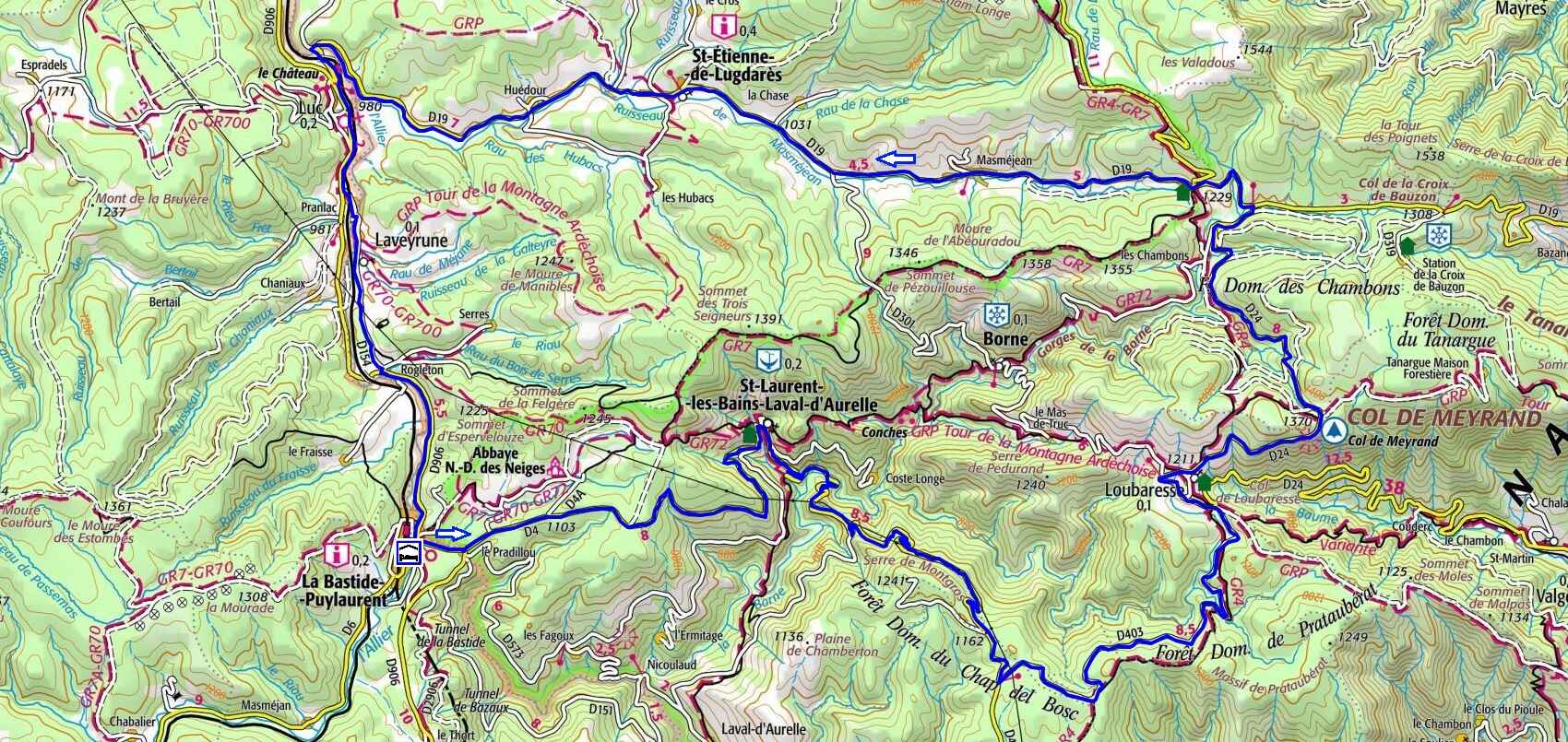60km bike tour at La Bastide-Puylaurent |
From l’etoile, head towards the village centre, then take the direction of Villefort opposite. Continue to the Pradillou roundabout, then follow the D4 straight on for 16.5 km, passing through Saint-Laurent-les-Bains and the Ceyrou bridge over the Borne (beautiful spots for swimming in granite pools), to the Col du Chap del Bosc. At the pass, turn left onto the D403 and drive for 7.8 km towards Loubaresse, passing the Croix de la Femme Morte and the Bournet bridge. At Loubaresse, turn left onto the D24 and follow it for 9.3 km, passing the Col de Meyrand, until you reach the D19. Then turn left and continue on this road for 17.1 km to Luc and the D906, crossing the Col du Bez, Masmejean, Saint-etienne-de-Lugdares and Huedour. When you reach the D906, turn left towards La Bastide-Puylaurent and drive for 1.7 km. Then take a left diagonally onto the D76 until the Pranlac bridge where you cross into Ardeche. It becomes the D154 which you follow until Rogleton, passing through Laveyrune. Finally, turn left onto the D906 to reach La Bastide.

20,5km - 25km - 27,7km - 30km - 35,2km - 37km - 41,5km - 44km - 48,4km - 57,5km - 59,4km - 60km - 60,5km - 69km - 70km - 76,8km - 77km - 81km - 90km - 95,7km
Google Maps - Google Earth - GPX








Distance: 60km. Maximum altitude: 1363m. Minimum altitude: 721m. Cumulative elevation: 1273m.
IGN maps: Langogne (2737E). La Bastide-Puylaurent (2738E). Largentiere la Bastide-Puylaurent Vivarais Cevenol (2838OT).
Print the route - Electric bike rental
In this province, the Haut-Vivarais and Bas-Vivarais share the space, the first rising in the north, the second extending in the south. The Vivarais mountains, stone sentinels of the eastern edge of the Massif Central. The tower of Saint Laurent les Bains, stone sentinel, stands proudly on a rocky spur overlooking the village. Built in the 9th century, it has survived the ages, its six floors preserved by the villagers as a sanctuary. Perched on the heights of the Borne valley, the village is crowned by the granite majesty of the Trois-Seigneurs, whose sides tumble down to the roofs that it overhangs by more than a hundred meters, watching over the souls below. The reputation of the thermal spa of Saint-Laurent-les-Bains dates back to the Roman era, its 53° waters celebrated for their therapeutic virtues. The Source of Saint-Laurent, born from the volcanic bowels of the earth, has been praised since the Middle Ages for its benefits. Treatments, such as weightless mud baths, showers in a thermal pool, poultices and vaporarium sessions, are provided in the privacy of three thermal establishments, where the waters flow through underground channels to offer healing and comfort to the many annual visitors.
There used to be, dominating the high mountains of these cold regions, four towers, those of Loubaresse, Borne, Saint-Laurent-les-Bains and Luc, at the top of which shone, when the night was dark, the fires lit by an immense brazier, luminous beacons that illuminated the region from afar, and served as signals during these feudal wars between lords, so disastrous and so frequent. Of these four towers, one has already disappeared. Placed at twelve hundred and forty-two meters above sea level, on the extinct and filled mouth of one of the oldest volcanoes of Vivarais, this tower which produced, seen from afar, such a picturesque and striking effect in the landscape, had been respected by time. But less than five years ago, a man came along who was not very fond of old ruins, and had it knocked down and razed to the ground, in order to use the materials for the reconstruction of the parish church of Loubaresse. From Chambons to Loubaresse, a village composed exclusively of muleteers, robust and bold mountaineers who have the courage and skill, but less the grace and coquettish elegance, of the Andalusian muleteers; and from Loubaresse to Chat-del-Bos, where the road passes which leads to Saint-Laurent-les-Bains, which is now only a league away, all well-trodden paths disappear. There are only meadows and fields in front of you, through which animals and people go on adventures.
The castle of Luc had its origins in a very ancient past, built on a site once occupied by the Celts, on the edge of the Mercoire forest, where the mysterious Tanargue massif was hidden. Its construction spread from the 6th to the 10th century, at a time when Gevaudan was an independent province, divided into eight baronies. Property of the lords of Luc, allied with the powerful barons of Randon and, through them, to the House of Joyeuse, one of the most illustrious noble families in France. The lords of Luc were renowned for their bravery, their piety and their sense of justice. They had the privilege of minting money, levying taxes, administering justice and waging war. Respected and feared by their vassals, they were also generous and protective towards the needy, the sick and pilgrims, who found refuge and assistance in their castle.
Former holiday hotel with a garden along the Allier, L'Etoile Guest House is located in La Bastide-Puylaurent between Lozere, Ardeche, and the Cevennes in the mountains of Southern France. At the crossroads of GR®7, GR®70 Stevenson Path, GR®72, GR®700 Regordane Way, GR®470 Allier River springs and gorges, GRP® Cevenol, Ardechoise Mountains, Margeride. Numerous loop trails for hiking and one-day biking excursions. Ideal for a relaxing and hiking getaway.
Copyright©etoile.fr